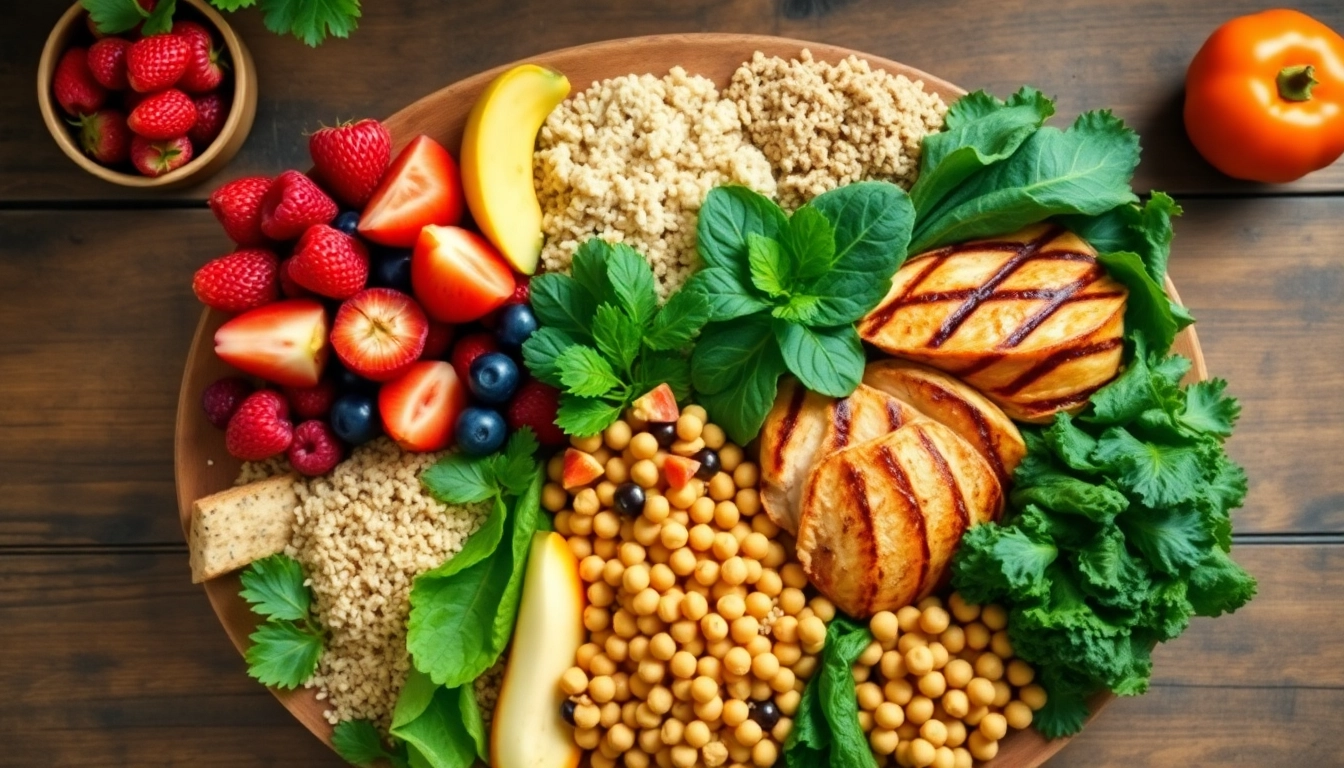Understanding Healthy Food Choices
In today’s fast-paced world, the importance of maintaining a healthy diet cannot be overstated. With so many food options available, understanding what constitutes healthy food is essential for making informed choices that benefit our overall well-being. A healthy diet provides our bodies with the necessary nutrients, energy, and support for emotional health, and it can even protect against chronic diseases.
What Constitutes Healthy Food?
Healthy food includes nutrient-dense options such as fruits, vegetables, whole grains, lean proteins, and healthy fats. These foods are packed with vitamins, minerals, and antioxidants that play crucial roles in bodily functions. In contrast, processed foods are often high in sugars, unhealthy fats, and sodium, which can lead to health issues when consumed in excess.
Key Nutrients in Healthy Foods
- Vitamins and minerals: Essential for various bodily functions, including immune support, energy production, and cell repair.
- Carbohydrates: The body’s primary energy source, especially when derived from whole grains and fruits.
- Protein: Vital for tissue growth, repair, and overall health. Sources include lean meats, legumes, and dairy.
- Fats: Necessary for hormone production and nutrient absorption, especially when sourced from nuts, seeds, and healthy oils.
- Fiber: Helps with digestion and can reduce the risk of Chronic diseases. Found in fruits, vegetables, and whole grains.
Benefits of Incorporating Healthy Foods into Your Diet
Incorporating healthy foods into your diet offers numerous benefits. Studies have shown that a balanced diet filled with nutrient-rich foods can lead to improved physical health, better mental well-being, and a lower risk of chronic diseases such as heart disease, diabetes, and obesity. Additionally, the right diet can improve energy levels and concentration, enhance mood, and support overall longevity.
Top 10 Healthy Foods to Include in Your Meals
List of Nutrient-Dense Healthy Foods
Choosing the right foods is essential for a nutritious diet. Here is a list of ten nutrient-dense healthy foods that you should consider including in your meals:
- Leafy Greens (e.g., spinach, kale, and swiss chard) – rich in vitamins A, C, and K, as well as fiber.
- Berries (e.g., blueberries, strawberries, raspberries) – packed with antioxidants and fiber.
- Fatty Fish (e.g., salmon, mackerel) – high in omega-3 fatty acids, which are good for heart health.
- Nuts and Seeds (e.g., almonds, chia seeds) – great sources of healthy fats, protein, and fiber.
- Whole Grains (e.g., quinoa, brown rice, and oats) – offer vitamins, minerals, and fiber.
- Legumes (e.g., beans, lentils) – high in protein and fiber.
- Sweet Potatoes – rich in vitamins, minerals, and antioxidants.
- Greek Yogurt – a probiotic-rich food that provides calcium and protein.
- Eggs – offer high-quality protein and essential nutrients.
- Cruciferous Vegetables (e.g., broccoli, cauliflower) – high in vitamins and may have cancer-fighting properties.
How to Prepare Healthy Foods Quickly
Time constraints often lead individuals to opt for quicker, less nutritious food options. However, preparing healthy meals doesn’t have to be time-consuming. Here are some tips for quick and easy meal prep:
- Batch Cooking: Prepare larger quantities of whole grains, roasted vegetables, or proteins at the beginning of the week, storing portions to use in various meals.
- Utilize a Slow Cooker or Instant Pot: These appliances can help you create healthy meals with minimal effort. Simply add the ingredients and let them cook while you attend to other tasks.
- Pre-cut Vegetables: Spend some time washing and chopping vegetables ahead of time. Keep them in the fridge for quick access when preparing meals.
- Choose Simple Recipes: Opt for recipes that require minimal ingredients and preparation time. Stir-fries, salads, and smoothies are excellent options.
- Make Use of Freezer-friendly Meals: Meals like soups, stews, and casseroles freeze well, making it easy to prepare ahead and enjoy on busy days.
Creative Ways to Incorporate Healthy Foods
Eating healthy should never feel dull or repetitive. Here are some creative ideas to incorporate healthy foods into your meals:
- Smoothies: Blend greens, fruits, and protein sources like yogurt or protein powder for a nutritious drink.
- Healthy Work Lunches: Prepare wrap sandwiches using whole-grain tortillas loaded with lean meats, veggies, and healthy spreads.
- Snack Smart: Replace chips or candy with mixed nuts or homemade energy bites made from oats, nut butter, and dried fruit.
- Vegetable Substitutes: Use cauliflower rice instead of white rice or zucchini noodles instead of pasta to boost the veggie content of your meals.
- Creative Salads: Elevate salads by adding protein like grilled chicken or chickpeas, and dress them with healthy homemade dressings.
Healthy Food Myths Debunked
Common Misconceptions About Healthy Food
The mainstream media and social networks are rife with misconceptions regarding healthy eating. Here, we debunk some of the most common myths:
- Myth: All Fats Are Bad: While trans fats are harmful, healthy fats (found in foods like avocados and nuts) are beneficial for heart health.
- Myth: Carbs Are the Enemy: Carbohydrates are essential for energy, especially when derived from whole, unprocessed sources like fruits and grains.
- Myth: Eating Healthy Is Expensive: Healthy eating can be budget-friendly. Opting for seasonal produce and bulk purchases can cut costs significantly.
- Myth: All Gluten-free Foods Are Healthy: Many gluten-free products are processed and can be high in sugars and fats. Always check ingredients.
- Myth: Supplements Replace Healthy Foods: Supplements should not replace a balanced diet. Whole foods provide complex nutrients that supplements cannot fully replicate.
The Truth About Carbs and Fats in Healthy Diets
Carbohydrates and fats are vital components of balanced diets. Carbs provide energy for daily activities, while healthy fats support hormone function and nutrient absorption. It’s essential to differentiate between complex carbs (like whole grains) and simple sugars (like sweets) or saturated and trans fats, which should be limited. Properly balancing carbs and fats can lead to sustained energy levels and overall health.
Healthy Food vs. Processed Food: Understanding the Differences
Understanding the difference between healthy and processed foods is fundamental for informed dietary choices. Healthy foods are typically whole and minimally processed, retaining their natural nutrients, while processed foods are often modified with additives and preservatives, stripping them of their nutritional value. To foster better health, prioritizing whole foods over processed options is crucial.
Healthy Food Meal Plans for Different Lifestyles
Meal Planning for Busy Professionals
Meal planning is a practical strategy for busy professionals who want to eat healthily. Here’s a one-week meal plan example:
- Breakfast: Overnight oats with chia seeds and berries.
- Lunch: Quinoa salad with chickpeas, cucumbers, tomatoes, and a lemon vinaigrette.
- Dinner: Grilled salmon with roasted sweet potatoes and steamed broccoli.
- Snacks: Greek yogurt with honey and nuts; apple slices with almond butter.
Healthy Food Options for Families
When planning meals for families, it’s important to cater to different tastes and preferences. Here’s a family-friendly meal plan that promotes healthy eating:
- Breakfast: Smoothie bowls topped with granola and fresh fruit.
- Lunch: Whole-grain wraps filled with turkey, lettuce, and hummus.
- Dinner: Vegetable stir-fry with tofu and brown rice.
- Snacks: Carrot sticks with ranch dip; popcorn seasoned with nutritional yeast.
Plant-Based Healthy Food Meal Plans
For those following a plant-based diet, focusing on variety is vital to ensuring intake of essential nutrients. A simple meal plan for a week could include:
- Breakfast: Avocado toast on whole-grain bread topped with a sprinkle of seeds.
- Lunch: Lentil soup with a side of mixed greens.
- Dinner: Cauliflower tacos with black beans, avocado, and salsa.
- Snacks: Almonds, dried fruit, or vegetable chips.
Tracking Your Progress with Healthy Food
Best Practices for Monitoring Your Healthy Food Intake
Keeping track of your food intake can enhance accountability and help improve eating habits. Consider these practices:
- Journaling: Writing down meals can help identify patterns and areas for improvement.
- Food Apps: Use mobile applications to log meals, track nutrients, and set dietary goals.
- Regular Check-ins: Periodically assess your eating habits and progress to stay motivated.
- Stay Educated: Continuously learning about nutrition can help enhance decision-making.
How to Adjust Your Diet for Optimal Nutrition
As personal circumstances and health objectives evolve, it’s vital to adjust your diet accordingly. This may involve increasing protein intake, reducing sugar, or incorporating more whole foods. Consulting with a dietitian can also provide tailored recommendations based on individual health needs.
Using Apps to Track Healthy Food Choices
The rise of health and nutrition apps provides tools to effectively monitor food choices. Some popular apps include:
- MyFitnessPal: Ideal for tracking calorie intake and macronutrient distribution.
- Lose It! Great for setting goals and comprehensive food tracking.
- Yummly: Offers meal planning features with healthy recipes tailored to dietary preferences.
- LifeSum: Helps track food intake while offering meal and recipe suggestions.
In conclusion, understanding healthy food choices and incorporating a variety of nutrient-dense foods into your meals is vital for achieving optimal health. By dispelling common myths, recognizing the benefits of healthy eating, and utilizing effective meal planning and tracking strategies, anyone can embark on a journey towards a healthier lifestyle.

